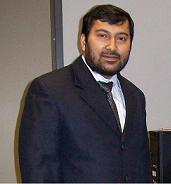|
|
 |
|
|
|
 |
|
Research Interests |
|
 |
|
 |
 |
Fluidization |
| |
Our
group has developed the first Liquid-Solid Circulating
Fluidized Bed (LSCFB) in Canada.
LSCFB widely been used in chemical, petrochemical,
biochemical and environmental processes given its
proficient mixing and superior heat and mass transfer
characteristics. The KSA has recognised that the reuse
of wastewater, after treatment, is the one of the most
viable long term solution to meet the increasing problem
of water demand in the country.
Currently there is a growing need for more efficient
biotechnological process in order to treat the
increasing volume of wastewater.Currently
one project funded by NSTIP-KACST going on collaboration
with Powder Technology Research Center (PTRC),
the
University of Western Ontario, Canada.
It
is also the aim of this study to investigate the scale
(up/down) effects on the hydrodynamics of the bioreactor
system by varying the size of the riser columns using
different size of the biofilm carriers. |
|
|
|
 |
CO2 capture
& Biofuel Production |
| |
Our research group actively working
on CO2 capture and wastewater treatment in
both Chemical and Biochemical Process system.
Microalgae cultivation in
photo-bioreactors by utilizing CO2 from point
sources (power plant, cement), wastewater (industrial,
municipal, dairy) as nutrient source and sunlight for
photosynthesis to produce biomass contains high oil and
starch making possible the production of high quality
biodiesel. Thus, microalgae culture can contribute to CO2
fixation, wastewater treatment and potential source of
bio-energy. Currently we have two projects in this
research field funded by KASCT and NSTIP-KACST. Two new
proposal submitted for funding in addition of current
projects in this vast area of research. |
|
|
|
 |
Biological-Wastewater Treatment |
| |
The
treatment of wastewater is the existence of recalcitrant
molecules that cannot efficiently be removed during
treatment. For such molecules, bioaugmentation has been
proposed as a viable strategy for their elimination.
Bioaugmentation consists of adding efficient
microorganisms to remove pollutants in wastewater
treatment plant, however, the main limitation of this
approach is the identification and isolation such of
efficient bacteria. Oil & grease (O&G), mainly from
cooking-oil and animal fat, are one of the contaminants
that are not efficiently removed from wastewater using
standard methods. The
main components of
O&G
are triglycerides, also known as esters
of fatty acids attached to a glycerol.
We have proposed to develop a
bioaugmentation strategy to efficiently clean wastewater
from O&G.
One of the funded project going on with collaboration of
biology department at
King Fahd University
of Petroleum & Minerals, Saudi Arabia. |
|
|
|
|
 |
|
Projects |
|
 |
|
 |
 |
Current Research Projects |
|
 |
| |
|
 |
Projects
Completed |
|
 |
| |
|
| |
| |
|
 |
Design of Downhole Gravity
Separation of Oil and Water: Phase I- Simulation
study for Technical Feasibility,
(ARAMCO Funded) |
| |
|
 |
Numerical Investigations of Flow
and Kinetics in a Partially Packed Catalytic
Claus Desulfurization Reactor.
(ARI-KFUPM) |
| |
|
|
|
|
| |
|
|
|
|
| |
|
|
|
|
|
|
|
|
|
|
|
|
|
| |
|
 |
| |
 |
|
Contact Info |
 |
Shaikh Abdur Razzak
Tel.: +966-3-860-7460
KFUPM Box: 5050
Dhahran 31261, Saudi Arabia
E-mail:
srazzak@kfupm.edu.sa |
| |
 |
| |
|
